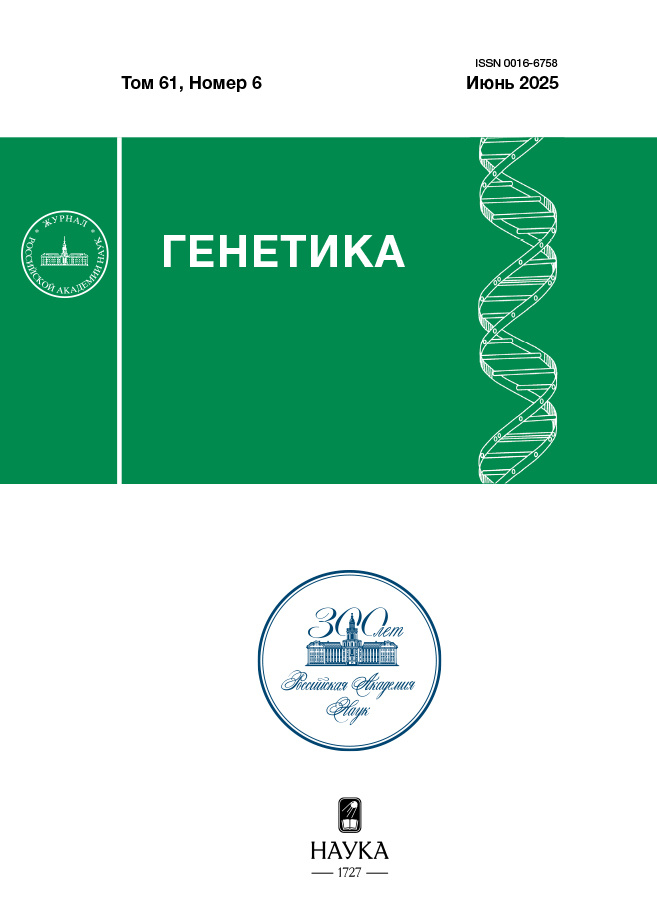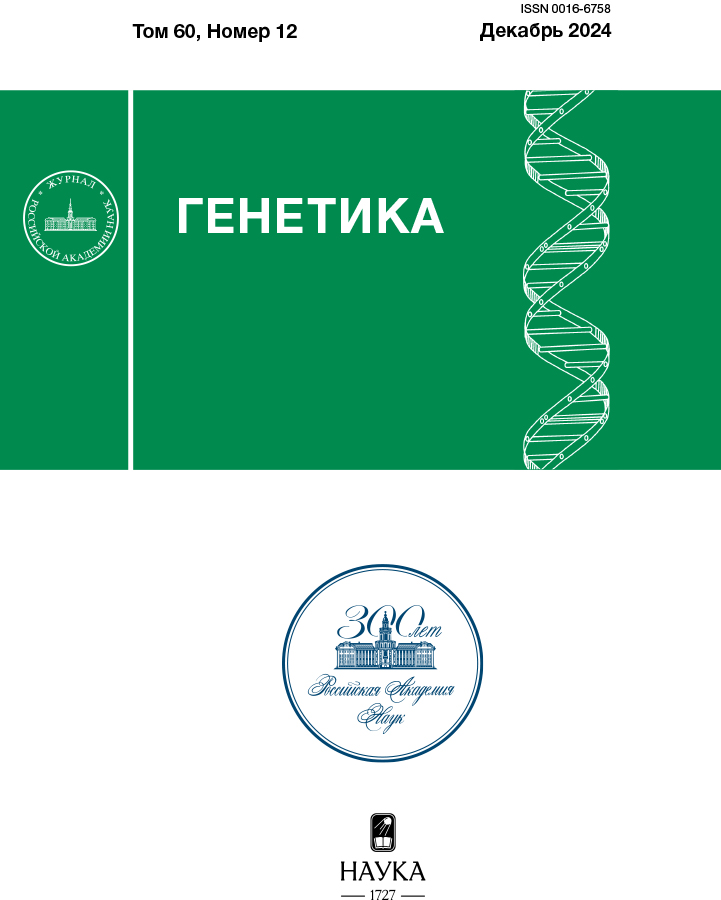Оценка полиморфизма генов иммунной системы TNF и TLR2 у крупного рогатого скота
- Авторы: Калашникова Л.А.1, Багаль И.Е.1, Муругина Н.Е.2, Калашников В.Е.1, Сенина Р.Ю.1
-
Учреждения:
- Всероссийский научно-исследовательский институт племенного дела
- Государственный научный центр “Институт иммунологии”
- Выпуск: Том 60, № 12 (2024)
- Страницы: 66–74
- Раздел: ГЕНЕТИКА ЖИВОТНЫХ
- URL: https://rjonco.com/0016-6758/article/view/676596
- DOI: https://doi.org/10.31857/S0016675824120079
- EDN: https://elibrary.ru/waawue
- ID: 676596
Цитировать
Полный текст
Аннотация
Представлены результаты генотипирования генов фактора некроза опухоли (TNF) и толл-подобного рецептора 2 (TLR2) у 644 голов крупного рогатого скота шести пород, относящихся по происхождению к четырем разным генетическим корням. Исследованы холмогорская и голштинская породы черно-пестрого корня, айрширская порода красного корня, костромская и бурая швицкая породы бурого корня и палевая симментальская порода. Для выявления аллелей и генотипов использовали метод ПЦР-ПДРФ. Установлены достоверные различия частоты встречаемости аллелей генов TNF и TLR2 между породами разных генетических корней (р < 0.001) и между породами молочного и молочно-мясного направления продуктивности (р < 0.001). У пяти пород скота из шести изученных по гену TLR2 выявлено преобладание аллеля T, наиболее высокая его частота (0.99) установлена у айрширской породы. Стадо айрширских коров близко к мономорфному типу по гену TLR2, 98% животных имеют гомозиготный генотип TТ. Более равномерное распределение аллелей и генотипов по гену TLR2 установлено у животных черно-пестрого корня: у голштинского скота средняя частота аллеля T составила 0.78, у холмогорского – 0.83. Генотип TТ выявлен у большинства голштинских (61%) и холмогорских (69%) коров. Частота аллеля T у симментальской породы составила 0.62, у костромской породы – 0.67. У симментальских и костромских коров чаще встречается гетерозиготный генотип TG (54 и 47% соответственно). Иная картина распределения частоты аллелей и генотипов выявлена у животных бурой швицкой породы. Частота аллеля T составляет в среднем 0.26. Более половины коров бурой швицкой породы (55%) имеют гомозиготный генотип GG. У всех пород по гену TNF преобладал аллель В с частотой встречаемости от 0.61 у голштинского скота до 0.98 у бурой швицкой породы. Высокая частота аллеля В установлена у костромской (0.94), айрширской (0.885) и симментальской (0.80) пород; у холмогорской породы выявлена средняя частота данного аллеля – 0.72. Наиболее высокая частота генотипа ВВ установлена в стадах бурой швицкой породы (96%). Выявлено преобладание гомозиготного генотипа ВВ у холмогорского (53%), симментальского (62%), айрширского (77%) и костромского скота (87.5%). У голштинских коров большинство животных (53%) представлены гетерозиготным генотипом АВ. У трех пород – айрширской, костромской и бурой швицкой – не выявлен генотип АА.
Ключевые слова
Полный текст
Об авторах
Л. А. Калашникова
Всероссийский научно-исследовательский институт племенного дела
Email: ladnatehplem@mail.ru
Россия, Московская область, г. Пушкино, 141212
И. Е. Багаль
Всероссийский научно-исследовательский институт племенного дела
Автор, ответственный за переписку.
Email: ladnatehplem@mail.ru
Россия, Московская область, г. Пушкино, 141212
Н. Е. Муругина
Государственный научный центр “Институт иммунологии”
Email: ladnatehplem@mail.ru
Россия, Москва, 115522
В. Е. Калашников
Всероссийский научно-исследовательский институт племенного дела
Email: ladnatehplem@mail.ru
Россия, Московская область, г. Пушкино, 141212
Р. Ю. Сенина
Всероссийский научно-исследовательский институт племенного дела
Email: ladnatehplem@mail.ru
Россия, Московская область, г. Пушкино, 141212
Список литературы
- Bjelka M., Novák K. Association of TLR gene variants in a Czech Red Pied cattle population with reproductive traits // Vet. Immunol. Immunopathol. 2020. V. 220. doi: 10.1016/j.vetimm.2019.109997
- Elmagharaby M.M., El-Nahas A.F., Fathala M.M. et al. Association of toll-like receptors 2 and 6 polymorphism with clinical mastitis and production traits in Holstein cattle // Iranian J. Veter. Res. 2018. V. 19. № 3. P. 202–207.
- Puerto M.A., Shepley E., Cue R.I. et al. The hidden cost of disease: I. Impact of the first incidence of mastitis on production and economic indicators of primiparous dairy cows // J. Dairy Sci. 2021. V. 104. № 7. P. 7932–7943. doi: 10.3168/jds.2020-19584
- Aghamohammadi M., Haine D., Kelton D.F. et al. Herd-level mastitis-associated costs on canadian dairy farms // Front. Veter. Sci. 2018. V. 5. doi: 10.3389/fvets.2018.00100
- Trinchieri G., Sher A. Cooperation of Toll-like receptor signals in innate immune defence // Nat. Rev. Immunol. 2007. V. 7. № 3. P. 179–190. doi: 10.1038/nri2038
- McGuire K., Jones M., Werling D. et al. Radiation hybrid mapping of all 10 characterized bovine Toll-like receptors // Anim. Genet. 2006. V. 37. № 1. P. 47–50.
- Zhang L.P., Gan Q.F., Ma T.H. et al. Toll-like receptor 2 gene polymorphism and its relationship with SCS in dairy cattle // Anim. Biotechnol. 2009. V. 20. P. 87–95. doi: 10.1080/10495390902873096
- Takeda K., Akira S. Toll-like receptors in innate immunity // Int. Immunol. 2005. V. 17. № 1. P. 1–14. doi: 10.1093/intimm/dxh186
- Akira S., Uematsu S., Takeuchi O. Pathogen recognition and innate immunity // Cell. 2006. V. 124. № 4. P. 783–801. doi: 10.1016/j.cell.2006.02.015
- Ozinsky A., Underhill D.M., Fontenot J.D. et al. The repertoire for pattern recognition of pathogens by the innate immune system is defined by cooperation between toll-like receptors // Proc. Natl Acad. Sci. USA. 2000. V. 97. № 25. P. 13766–13771. doi: 10.1073/pnas 250476497
- Inrning Huang J., Liu L., Wang H. et al. Variants and gene expression of the TLR2 gene and susceptibility to mastitis in cattle // Asian J. Anim. Veter. Adv. 2011. V. 6. P. 51–61. doi: 10.3923/ajava.2011.51.61
- Raufian P., Shodja Ghyas J., Jafari R. et al. Identification of genetic variation in two candidate genes of TLR2 and TNFα and its association with mastitis in Holstain Cattle // Res. Anim. Prod. (Sci. Res.). 2018. V. 8. P. 147–154. doi: 10.29252/rap.8.18.147
- Goldammer T., Zerbe H., Molenaar A. et al. Mastitis increases mammary mRNA abundance of β-defensin 5, toll-like-receptor 2 (TLR2), and TLR4 but not TLR9 in cattle // Clin. Diagn. Lab. Immunol. 2004. V. 11. № 1. P. 174–185. doi: 10.1128/CDLI.11.1.174-185.2004
- Sadana T., Singh R., Singh Sh. et al. Single nucleotide polymorphism of SLC11A1, CARD15, IFNG and TLR2 genes and their association with Mycobacterium avium subspecies paratuberculosis infection in native Indian cattle population // Indian J. Biotechnol. 2015. V. 14. P. 469–475.
- Koets A., Santema W., Mertens H. et al. Susceptibility to paratuberculosis infection in cattle is associated with single nucleotide polymorphisms in Toll-like receptor 2 which modulate immune responses against Mycobacterium avium subspecies paratuberculosis // Prev. Veter. Med. 2010. V. 93. № 4. P. 305–315. doi: 10.1016/j.prevetmed.2009.11.008
- Bartens M.C., Gibson A.J., Etherington G.J. et al. Single Nucleotide polymorphisms in the bovine TLR2 extracellular domain contribute to breed and species-specific innate immune functionality // Front. Immunol. 2021. V. 12. doi: 10.3389/fimmu.2021.764390
- Bhaladhare A., Sharma D., Kumar A. et al. Single nucleotide polymorphisms in Toll-like receptor genes and case-control association studies with bovine tuberculosis // Veter. World. 2016. V. 9. № 5. doi: 10.14202/vetworld.2016.458-464
- Huang L.Y., Aliberti J., Leifer C.A. et al. Heat-killed Brucella abortus induces TNF and IL-12p40 by distinct MyD88-dependent pathways: TNF, unlike IL-12p40 secretion, is Toll-like receptor 2 dependent // J. Immunol. 2003. V. 171. № 3. P. 1441–1446. doi: 10.4049/jimmunol.171.3.1441
- Aggarwal B.B., Kohr W.J., Hass P.E. et al. Human tumor necrosis factor. Production, purification, and characterization // J. Biol. Chem. 1985. V. 260. № 4. P. 2345–2354.
- Pennica D., Nedwin G.E., Hayflick J.S. et al. Human tumour necrosis factor: Precursor structure, expression and homology to lymphotoxin // Nature. 1984. V. 312 (5996). P. 724–729. doi: 10.1038/312724a0
- Agaba M., Kemp S.J., Barendse W., Teale A.J. Polymorphism at the bovine tumor necrosis factor alpha locus and assignment to BTA23 // Mamm. Genome. 1996. V. 7. P. 186−187. doi: 10.1007/s003359900051
- Grosse W.M., Kappes S.M., Laegreid W.W. et al. Single nucleotide polymorphism (SNP) discovery and linkage mapping of bovine cytokine genes // Mamm. Genome. 1999. V. 10. № 11. P. 1062–1069. doi: 10.1007/s003359901162
- Bannerman D.D. Pathogen-dependent induction of cytokines and other soluble inflammatory mediators during intramammary infection of dairy cows // J. Anim. Sci. 2009. V. 87 (13 Suppl.). P. 10–25. doi: 10.2527/jas.2008-1187
- Bradley J.R. TNF-mediated inflammatory disease // J. Pathol. 2008. V. 214. № 2. P. 149–160. doi: 10.1002/path.2287
- Raoofian P., Shoja J., Moghadam G.H., Javanmard A. Association investigation and gene expression in genotypes TNFα with somatic cell score in Holstein Dairy cattle // Iranian J. Veter. Clin. Sci. Fall. 2018. V. 12. № 2. P. 59–134.
- Wojdak-Maksymiec K., Szyda J., Strabel T. Parity-dependent association between TNF-α and LTF gene polymorphisms and clinical mastitis in dairy cattle // BMC Vet. Res. 2013. V. 9. doi: 10.1186/1746-6148-9-114
- Xu A.J., Liu X.L., Guo J.Z., Xia Z. Polymorphism of bovine TNF-a gene and its association with mastitis in Chinese Holstein cows // Yi Chuan. 2010. V. 32. № 9. P. 929–934.
- Bojarojć-Nosowicz B., Kaczmarczyk E., Stachura A., Kotkiewicz M. Polymorphism in the promoter region of the tumor necrosis factor-alpha gene in cattle herds naturally infected and uninfected with the bovine leukemia virus // Polish J. Vet. Sci. 2011. V. 14. № 4. P. 671–673. doi: 10.2478/v10181-011-0101-0
- Lendez P.A., Passucci J.A., Poli M.A. et al. Association of TNF-a gene promoter region polymorphisms in bovine leukemia virus (BLV)-infected cattle with different proviral loads // Arch. of Virology. 2015. V. 160. № 8. P. 2001–2007. doi: 10.1007/s00705-015-2448-5
- Cheng Y., Huang C., Tsai H. Relationship of bovine TNF-α gene polymorphisms with the risk of bovine tuberculosis in Holstein cattle // J. Vet. Med. Sci. 2016. V. 78. № 5. P. 727–732. doi: 10.1292/jvms.15-0506
- Kawasaki Y., Aoki Y., Magata F. et al. The effect of single nucleotide polymorphisms in the tumor necrosis factor-α gene on reproductive performance and immune function in dairy cattle // J. Reprod. and Development. 2014. V. 60. № 3. P. 173–178. doi: 10.1262/jrd.2013-140
- Bimenova Zh.Zh., Makashev Y.K., Turyspayeva Sh.D. et al. The effect of the TNF-α gene alleles in Holstein cows on reproductive function // J. Pharmaceutical Sci. and Res. 2018. V. 10. № 4. P. 903–906.
- Kahl S., Proszkowiec Wegla M.K., Connor E.E., Elsasser T.H. Association of tumor necrosis factor-alpha (TNF-alpha) gene promoter polymorphisms with TNF-alpha response to endotoxin (LPS) in calves // J. Animal Sci. Abstract. 2008. V. 86. P. 195.
- Prebavathy T., Thanislass J., Dhanammal L. et al. Association between SNPs in TLR2 gene segment corresponding to LRR functional domain of TLR2 receptor and bovine mastitis // Asian J. Animal Sci. 2015. V. 9. P. 45–56.
- Oner Y., Ata N., Karabaş M., Yilmaz O. Investigation of TLR2 -EcoRV, NOD2- BsaHI ve IFNγ- HphI allele frequency distribution among Turkish Native Cattle Breeds // Turkish J. Agriculture. Food Sci. and Technol. 2022. V. 10. № 6. P. 992–996. doi: 10.24925/turjaf.v10i6.992-996.4701













